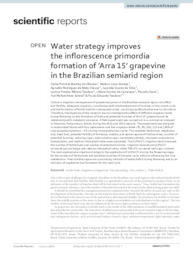Water strategy improves the inflorescence primordia formation of ’Arra 15’ grapevine in the Brazilian semiarid region.
Water strategy improves the inflorescence primordia formation of ’Arra 15’ grapevine in the Brazilian semiarid region.
Summary: Failure in irrigation management of grapevines grown in the Brazilian semiarid region can affect bud fertility. Adequate irrigation, considering both the development of bunches in the current cycle and the formation of fertile buds for subsequent cycles, can bring significant advances to viticulture. Therefore, the objective of this research was to investigate the effect of different irrigation levels during flowering on the formation of buds and potential bunches of ’Arra 15’ grapevine and its relationship with metabolic processes. A field experiment was carried out in a commercial vineyard in Petrolina, Pernambuco, Brazil, during the 2021 and 2022 seasons. The experiment was designed in randomized blocks with four replications and five irrigation levels (70; 85; 100; 115 and 130% of crop evapotranspiration – ETc) during three production cycles. The variables fertile bud, vegetative bud, dead bud, potential fertility of the basal, median, and apical regions of the branches, number of potential bunches, reducing sugar, total soluble sugar, net photosynthesis, stomatal conductance, transpiration, and relative chlorophyll index were evaluated. The 115% ETc irrigation level improved the number of fertile buds and number of potential bunches. Irrigation level above 115% ETc increased gas exchange and relative chlorophyll index, while 70% ETc increased leaf sugar content. The most appropriate irrigation strategy is the application of 115% ETc during the flowering stage, for the increase of fertile buds and potential bunches of the next cycle, without influencing the vine metabolism. Total soluble sugars are a promising indicator of water deficit during flowering and as an indicator of vegetative bud formation for the next cycle.
Publication year: 2024
Types of publication: Journal article
Unit: Embrapa Semi-arid Region
Observation
Some of Embrapa's publications are published as ePub files. To read them, use or download one of the following free software options to your computer or mobile device. Android: Google Play Books; IOS: iBooks; Windows and Linux: Calibre.
Access other publications
Access the Agricultural Research Database (BDPA) to consult Embrapa's full library collection and records.
Visit Embrapa Bookstore to purchase books and other publications sold by Embrapa.

